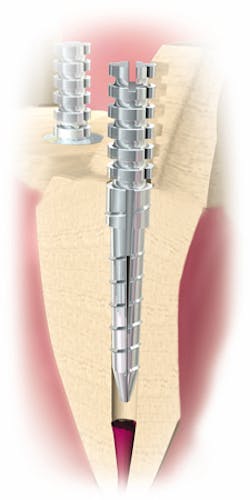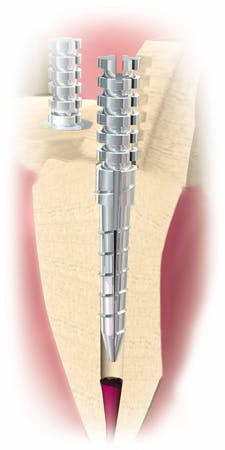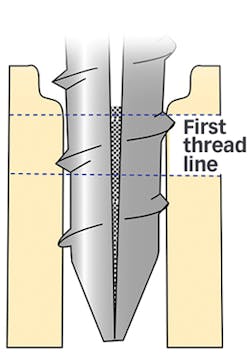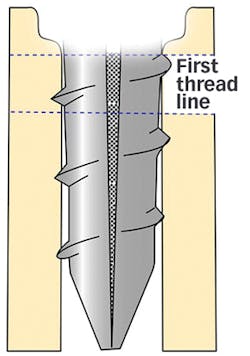Endodontic posts: Choosing the optimum material and design
The purpose of an endodontic post is to help restore or reinforce the coronal structure of a tooth, further increasing the retention and stability of an artificial crown. Removing tooth structure to place a post does not increase the resistance of the root to vertical or horizontal fracture.
If a stiff metal post is placed, it minimizes the crown, which is supported by the post and core, from bending under function. In turn, this reduces stresses at the margins of the restoration. A stiff post does not absorb stress; rather, it transmits these functional stresses to the dentinal walls that support the shaft. If a force were applied to the post that exceeded the strength of the supporting walls, the tooth would indeed fracture. The fact that nonmetallic posts absorb some of the functional stresses means that less stress is transmitted to the canal walls, and there is less chance of root fracture if the force applied exceeds the strength of the supporting root.1 This would suggest that it is preferable to use a nonmetallic post-except for the fact that a flexible post is incompatible with a stable core, which is incompatible with a stable crown.
ALSO BY DR. ALLAN S. DEUTSCH |4 secrets to successful endodontics procedures
For a stiff metal post to fracture a root, it would have to generate forces greater than the oral musculature can generate.2 When destructive tests are performed on Flexi-Posts (Essential Dental Systems Inc.), for example, the amount of stress needed to yield a fracture is routinely greater than the jaw can produce.3 On the other hand, nonmetallic posts, while not likely to cause a fracture, have insufficient rigidity to resist deformation under normal function. This leads to a breakdown of core materials, gap formation, and ultimately secondary decay.4
The ideal post should have minimal insertional stresses, have an even distribution of functional stresses, and be highly resistant to bending.5,6 The first two qualities protect the root. The third quality protects the core.
Figure 1: Illustration of a Flexi-Post
Of all post designs, the mechanical retention provided by threaded posts produce the greatest retention. By engaging the dentin, the threads produce retentive values that are at least three times higher than the highest retention of passive systems.7 The historical problem with threaded posts is the excessive stress they convey to the root as they are being threaded in. Solid shanked posts concentrate stresses of insertion to the lead thread, as this thread is doing all the work; all the other threads are merely following in its wake. As a result, insertional stresses are concentrated around that lead thread. Given the penetration of this lead thread, there is no question that excessive insertional stresses would accompany the creation of the groove produced by the lead thread, with root fracture being a high possibility.
ALSO BY DR. BARRY L. MUSIKANT | Endodontic insight: Optimum endodontic irrigation techniques
The split-shank design of the Flexi-Post (figure 1) post system solved the paradox of high retention versus high insertional stresses.8 The split-shanked design acts as a graduated tap, giving the post the ability to sequentially deepen machined grooves into the dentin of the canal walls.9
The shank of the post has a split along most of its length. The first thread does not approach maximum embedment. Rather, as soon as the lead thread touches the walls of the canal, it begins to collapse upon itself (figure 2). Because the legs are flexible, the degree of insertion and the amount of insertional stresses are significantly reduced from that of the lead thread on a solid shank. The next thread is situated on a portion of the shank that is less flexible because it is nearer the origin of the split. Consequently, it penetrates deeper into the canal walls (figure 3). It further deepens the groove already started by the lead thread, which is an incremental or graduated deepening. The third thread from the tip is on a part of the shank that is even less flexible (closer to the split's origin) and again deepens the groove incrementally in a graduated fashion (figure 4).10
Figure 2: Insertion of the first thread of the Flexi-Post into the root, demonstrating the adaptation of the shank
Figure 3: Insertion of the second thread of the Flexi-Post into the root, demonstrating the adaptation of the shank
Figure 4: Insertion of the third thread of the Flexi-Post into the root, demonstrating the adaptation of the shank
Ultimately, the grooves for the threads on the post are prepared. The further up the shank, the deeper the grooving because they have been exposed to a greater number of threads on the shank of the post. The split design results in an absolute decrease in the degree of insertional stresses. More importantly, the split-shanked design results in a fairly even distribution of stresses along the entire length of the shank in the root.11 Rather than having the insertional stresses concentrated around the lead thread, whatever reduced amount of insertional stresses are present are distributed benignly over the entire length of the post's shank.12
Under function, a split-shank threaded post can actually produce less stress to the tooth than a passively placed post. Certainly it cannot produce less insertional stress, because the very definition of a passive post is one that produces no insertional stresses. However, when one considers functional stresses, the split-shanked design distributes its functional stresses fairly evenly around all of the embedded threads. A parallel passive metal post that has the strength to stand up to functional forces without bending will distribute most of these forces through the shank, concentrating them at the apical tip of the post placement. A concentration of functional stresses, rather than an even distribution along the length of the shank, may be a strong secondary cause of root fracture. Research demonstrates that a split-shank design withstands higher functional stress loads than passive post designs.4
References
1. Newman MP, Yaman P, Dennison J, Rafter M, Billy E. Fracture resistance of endodontically treated teeth restored with composite posts. J Prosthet Dent. 2003;89(4):360-367.
2. Pegoretti A, Fambri L, Zappini G, Bianchetti M. Finite element analysis of a glass fibre reinforced composite endodontic post. Biomaterials. 2002;23(13):2667-2682.
3. Burgess JO, Summitt JB, Robbins JW. The resistance to tensile, compression, and torsional forces provided by four post systems. J Prosthet Dent. 1992;68(6):899-903.
4. Sabio S, Mondelli J, Bonachela V, Sabio SS. A comparative study of the fracture resistance of endodontically treated teeth between metal cast post and two resin-reinforced prefabricated systems in the intraradicular restoration. J Dent Res. 2002;81(Abstract 0324):A-67.
5. Wilson NH, Setcos JC, Dummer PM, et al. A split-shank prefabricated post system: a critical multidisciplinary review. Quintessence Int. 1997;28(11):737-743.
6. Drummond JL, Bapna MS. Static and cyclic loading of fiber-reinforced dental resin. Dent Materials. 2003;19:226-231.
7. Brown JD. Retentive properties of dowel post systems. Oper Dent. 1987;12:15-19.
8. Musikant BL, Deutsch AS. Endodontic post and cores, part two-design of the Flexi-Post. J Alabama Dent. 1985;69:42-46.
9. Deutsch AS, Musikant BL. The Flexi-Post as a tap-in post placement. General Dentistry. 1986;146-147.
10. Deutsch AS, Musikant BL, Antenucci G, Giusti P. Adaptation of a prefabricated post to dentin. J Prosthet Dent. 1985;53:182-184.
11. Cohen BI, Volovich Y, Musikant BL, Deutsch AS. Comparison of the photoelastic stress properties for different post-core combinations. Oral Health. 2001;91(10):63-72.
12. Cohen BI, Volovich Y, Musikant BL, Deutsch AS. Photoelastic stress properties for different post-core combinations. J Dent Res. 2002;81(Abstract 3478):A-428.
Allan S. Deutsch, DMD, FACD, and Barry L. Musikant, DMD, FACD, are codirectors of dental research and cofounders of Essential Dental Systems (EDS). They have authored more than 350 clinical articles published in domestic and international dental journals. Both are distinguished members of some of dentistry's most prestigious bodies. Practicing in Manhattan, New York, their 80-plus years of combined practice experience have crafted them into two of the top authorities in endodontics.




